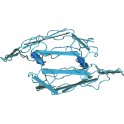
- Remove this product from my favorite's list.
- Add this product to my list of favorites.
Products
Viewed products
Newsletter
 |  |  |  |  |  |

Background
Kinase insert domain receptor (KDR) also known as CD309, FLK1, VEGFR, VEGFR2, and is one of the subtypes of VEGFR. VEGF receptors are receptors for vascular endothelial growth factor (VEGF). There are three main subtypes of VEGFR, numbered 1, 2 and 3. The VEGF receptors have an extracellular portion consisting of 7 immunoglobulin-like domains, a single transmembrane spanning region and an intracellular portion containing a split tyrosine-kinase domain. VEGF-A binds to VEGFR-1 (Flt-1) and VEGFR-2 (KDR/Flk-1). VEGFR-2 appears to mediate almost all of the known cellular responses to VEGF.The function of VEGFR-1 is less well defined, although it is thought to modulate VEGFR-2 signaling. Another function of VEGFR-1 may be to act as a dummy/decoy receptor, sequestering VEGF from VEGFR-2 binding (this appears to be particularly important during vasculogenesis in the embryo).[1-3] In addition, VEGFR2 is able to interact with HIV-1 extracellular Tat protein upon VEGF activation, and seems to enhance angiogenesis in Kaposi\'s sarcoma lesions.
Source
Recombinant Mouse VEGF R2, Mouse IgG2a Fc Tag, low endotoxin (VE2-M5258) is expressed from human 293 cells (HEK293). It contains AA Ala 20 - Glu 762 (Accession # P35918-1).
Predicted N-terminus: Ala 20
Molecular Characterization
This protein carries a mouse IgG2a Fc tag at the C-terminus. The protein has a calculated MW of 110.1 kDa. The protein migrates as 120-135 kDa under reducing (R) condition (SDS-PAGE) due to glycosylation.
Endotoxin
Less than 1.0 EU per µg by the LAL method.
Purity
>95% as determined by SDS-PAGE.
Formulation
Lyophilized from 0.22 μm filtered solution in 50 mM Tris, 100 mM Glycine, pH7.5 with trehalose as protectant.
Reconstitution
Please see Certificate of Analysis for specific instructions.
For best performance, we strongly recommend you to follow the reconstitution protocol provided in the CoA.
Storage
For long term storage, the product should be stored at lyophilized state at -20°C or lower.
Please avoid repeated freeze-thaw cycles.
This product is stable after storage at:
-20°C to -70°C for 12 months in lyophilized state;
-70°C for 3 months under sterile conditions after reconstitution.
Bioactivity
Please refer to product data sheet.
(1) "Barrier-penetrating liposome targeted delivery of basic fibroblast growth factor for spinal cord injury repair"
Wu, Wang, Wei et al
Mater Today Bio (2023) 18, 100546
(2) "Evaluation of Multiple Machine Learning Models for Predicting Number of Anti-VEGF Injections in the Comparison of AMD Treatment Trials (CATT)"
Chandra, Ying
Transl Vis Sci Technol (2023) 12 (1), 18
(3) "A cross-sectional study comparing the inflammatory profile of menstrual effluent vs. peripheral blood"
Naseri, Rosenberg-Hasson, Maecker et al
Health Sci Rep (2023) 6 (1), e1038
Showing 1-3 of 1047 papers.
Follow us